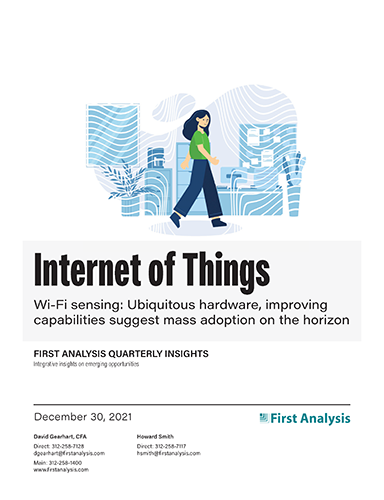Quarterly insights: Internet of Things
Wi-Fi sensing: Ubiquitous hardware, improving capabilities suggest mass adoption on the horizon

In our two most recent Internet of Things (IoT) reports, we examined two technologies – cameras and microphones – that can be used in place of traditional sensors to capture data. Here, we continue to explore this theme, moving beyond image and sound to Wi-Fi sensing, or using Wi-Fi networks as sensors. The world is beginning to wake up to the fact that the Wi-Fi devices we use for the simple purpose of accessing the internet and transmitting data actually represent an enormous untapped resource for sensing the environment around us.
Wi-Fi devices propagate radio waves in virtually all directions and broadcast continuously even when they’re not sending data packets, making it possible to use them as highly capable IoT sensors by measuring and interpreting changes in the radio waves as they travel through their environment.
Wi-Fi’s pervasiveness, both in terms of where it is already deployed and its complete environmental coverage, means it is an inexpensive and flexible resource for “seeing” and measuring the world and gives rise to compelling applications for Wi-Fi sensing in areas like security, automation and wellness.
Current commercial Wi-Fi sensing solutions can recognize when people are present by detecting motion. However, many more capabilities are nearing commercialization, and we expect Wi-Fi sensing’s low deployment costs and unique sensor capabilities combined with steady improvements in technology to drive impressive adoption over the next few years.
We highlight a few of the companies targeting this emerging market and its transformational potential.
TABLE OF CONTENTS
Includes discussion of five private companies
- How Wi-Fi detects presence and motion
- Wide range of uses
- Advantages, benefits to drive adoption
- Standardization and improvements should further drive adoption
- Initially a complementary IoT solution, eventually a substitute in some situations
- Positioning for success
- A sleeper technology with transformational potential
- IoT index lags Nasdaq
- M&A slows to close out strong year
- Private placement activity at new quarterly high
How Wi-Fi detects presence and motion
Most of us know Wi-Fi as the short-range wireless networking technology used by our laptops, tablets, smartphones and other devices (Table 1) to access the internet. These devices use dedicated wireless chipsets and antennas to send and receive radio signals in local networks, encoding and decoding data as needed. Wi-Fi networks consist of gateways, routers, access points and extenders built with chipsets that are compatible across manufacturers. At least one device on each Wi-Fi network connects to the internet with a cellular radio or wireline. The number of Wi-Fi devices on a network and the radio frequencies they use dictate the network’s range and data capacity.

Request full report
To access the full report, please provide your contact information in the form below. Thank you for your interest in First Analysis research.
